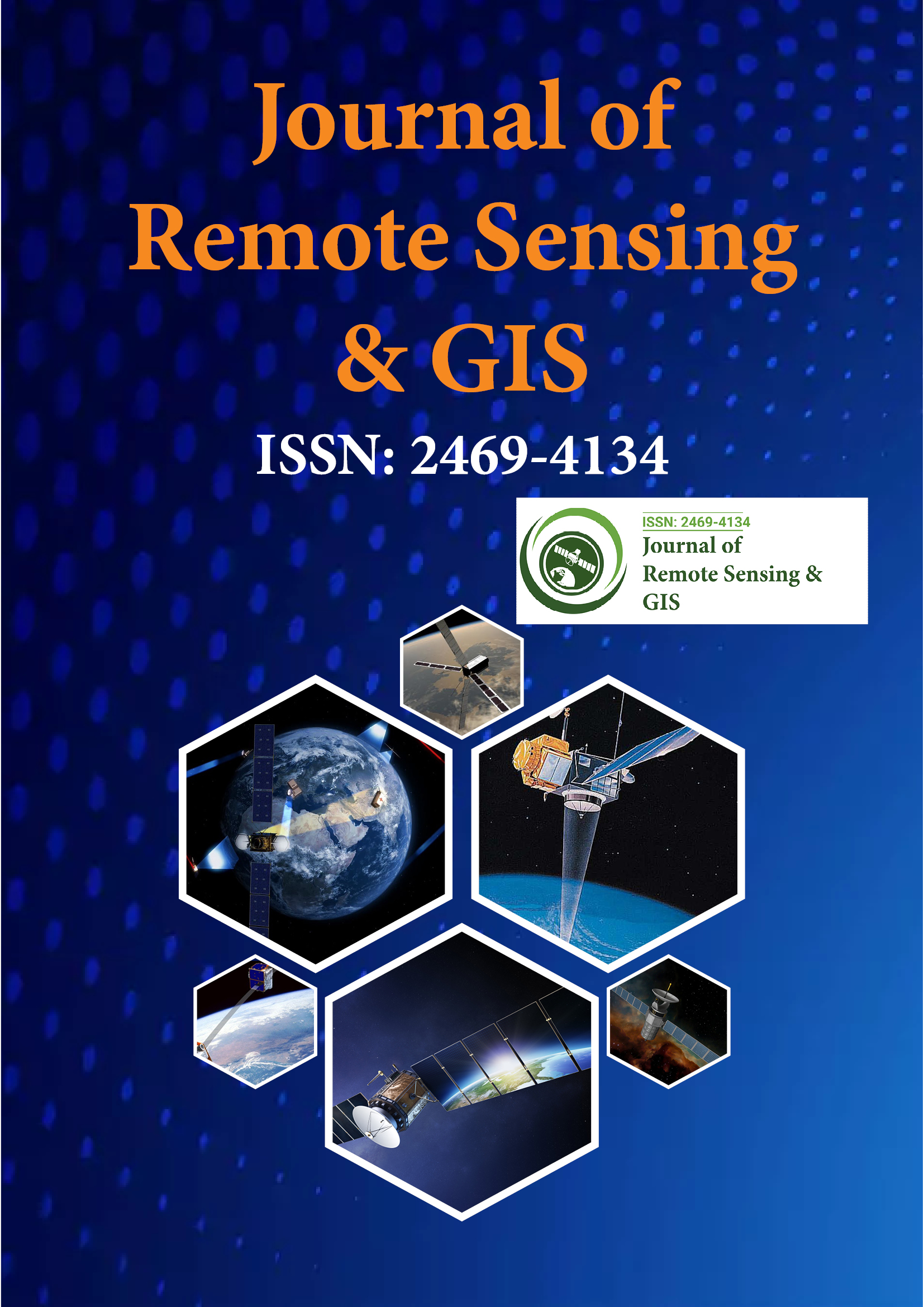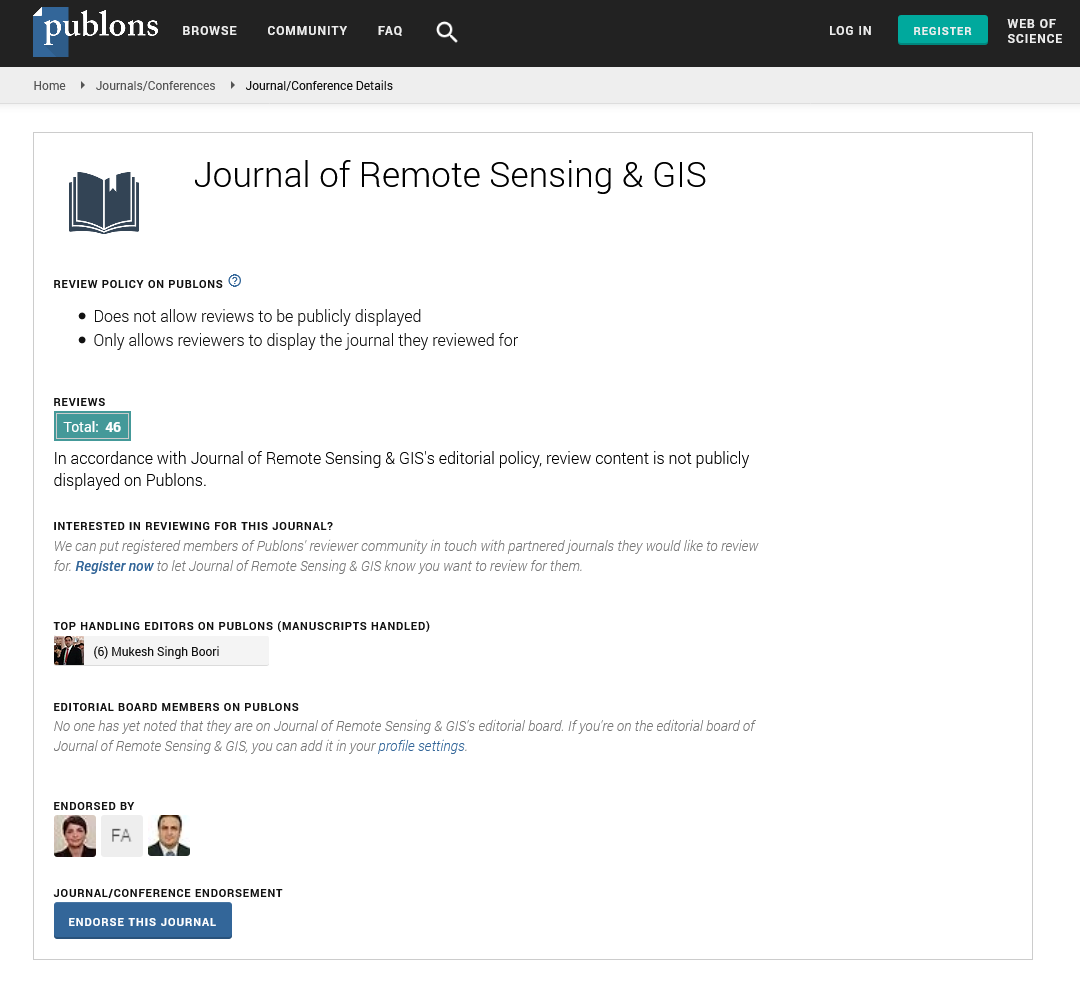Indexed In
- Open J Gate
- RefSeek
- Hamdard University
- EBSCO A-Z
- OCLC- WorldCat
- Publons
- International Scientific Indexing
- Euro Pub
- Google Scholar
Useful Links
Share This Page
Journal Flyer

Open Access Journals
- Agri and Aquaculture
- Biochemistry
- Bioinformatics & Systems Biology
- Business & Management
- Chemistry
- Clinical Sciences
- Engineering
- Food & Nutrition
- General Science
- Genetics & Molecular Biology
- Immunology & Microbiology
- Medical Sciences
- Neuroscience & Psychology
- Nursing & Health Care
- Pharmaceutical Sciences
Opinion Article - (2025) Volume 14, Issue 2
Remote Sensing for Coastal Zone Monitoring and Management
Cameroon Patrick*Received: 06-Jun-2025, Manuscript No. JGRS-25-29360; Editor assigned: 09-Jun-2025, Pre QC No. JGRS-25-29360 (PQ); Reviewed: 23-Jun-2025, QC No. JGRS-25-29360; Revised: 30-Jun-2025, Manuscript No. JGRS-25-29360 (R); Published: 07-Jul-2025, DOI: 10.35248/2469-4134.24.14.387
Description
Coastal zones represent some of the most dynamic and densely populated regions of the world, serving as hubs for commerce, tourism, biodiversity and livelihood activities. At the same time, they are highly susceptible to natural hazards such as erosion, storm surges, sea level rise and pollution. Managing coastal environments requires timely and accurate information on physical, ecological and anthropogenic processes occurring along the shorelines. Remote sensing provides a valuable means of collecting spatial and temporal data over coastal areas, enabling effective monitoring and informed management decisions.
Satellites equipped with optical, radar and thermal sensors allow for the observation of coastline features, land cover, water quality and geomorphological changes. One of the primary applications of remote sensing in coastal monitoring is shoreline mapping. Through high-resolution satellite imagery and aerial photographs, the position of the shoreline can be delineated with precision. By analyzing imagery over time, researchers can assess erosion rates, accretion zones and overall changes in coastal morphology.
Beach erosion is a widespread problem, exacerbated by human activity and climate variability. Multi-temporal satellite images, such as those from Landsat and Sentinel-2, can reveal patterns of shoreline retreat or advance. This information is used to prioritize areas for protection or restoration, such as the installation of breakwaters, dune stabilization, or managed retreat strategies. Synthetic Aperture Radar (SAR) imagery, such as from Sentinel-1, is particularly useful for monitoring shorelines in cloudy or stormy conditions where optical imagery may be unavailable.
Coastal wetlands, including mangroves, salt marshes and estuaries, provide important ecosystem services such as carbon sequestration, water purification and storm buffering. These habitats are under pressure from coastal development, pollution and sea level rise. Remote sensing enables the classification and monitoring of these habitats using spectral indices like the Normalized Difference Vegetation Index (NDVI) and the Normalized Difference Water Index (NDWI). Changes in these indices over time indicate habitat degradation, dieback, or encroachment by human activities.
Another key application is the monitoring of water quality in coastal and estuarine environments. Parameters such as chlorophyll concentration, turbidity, suspended sediments and surface temperature can be estimated using satellite-derived spectral data. Remote sensing helps detect harmful algal blooms, sediment plumes and pollution events, which may originate from agricultural runoff, sewage discharge, or industrial activity. This real-time monitoring capacity supports marine spatial planning, aquaculture operations and public health advisories.
Land use changes in coastal catchments directly influence the condition of coastal ecosystems. By classifying land cover and tracking urban expansion, deforestation, or agricultural intensification, remote sensing allows for the identification of upstream activities affecting coastal zones. This connection supports integrated coastal zone management by linking inland planning with downstream effects. For example, clearing of coastal vegetation can increase sediment loading and alter estuarine dynamics, while urban runoff may contribute to nutrient loading and eutrophication.
Remote sensing also plays a role in assessing the impacts of extreme weather events. Hurricanes, typhoons and cyclones can cause significant damage to coastal infrastructure, vegetation and topography. Post-event imagery is used to map the extent of inundation, identify affected structures and estimate debris accumulation. Comparing pre- and post-disaster imagery provides a rapid assessment for response planning and recovery efforts. SAR data is especially useful during and after storm events when cloud cover hampers optical observations.
Sea level rise is an ongoing concern for low-lying coastal regions. While satellite altimetry missions such as TOPEX/Poseidon and Jason series provide global measurements of sea level trends, remote sensing contributes to local assessments by mapping high-tide lines, coastal topography and inundation extents. These data support vulnerability assessments and adaptation planning, particularly in deltaic and island settings. Coastal flood risk models often incorporate satellite-derived elevation and land cover data to simulate future scenarios.
Bathymetry, or the mapping of underwater terrain, is also supported by remote sensing through techniques such as satellite-derived bathymetry. Using multispectral imagery and water column corrections, depths in shallow coastal waters can be estimated. This information is valuable for navigation, habitat mapping and coastal engineering. While not as precise as sonar-based surveys, satellite bathymetry provides broader coverage and supports baseline assessments.
Remote sensing data is increasingly accessible through cloudbased platforms and open-data initiatives. Tools like Google Earth Engine and NASA’s earth data portal allow users to access and analyze satellite imagery with minimal technical barriers. Combined with Geographic Information Systems (GIS), these tools support interactive mapping, scenario modeling and decision support for coastal planners and environmental managers.
Despite its many advantages, remote sensing for coastal monitoring also has limitations. Optical imagery is affected by cloud cover, atmospheric interference and turbidity in water. Spectral similarity between land cover types can complicate classification. Ground validation through field surveys, GPS measurements and drone imagery is important to calibrate and verify remote sensing outputs. Collaboration among scientists, government agencies and local communities enhances the interpretation and application of remote sensing data.
In conclusion, remote sensing provides a comprehensive and scalable means of monitoring coastal zones, capturing dynamic processes and human influences that shape these environments. By enabling the observation of shoreline change, habitat condition, water quality and post-disaster impacts, satellite imagery supports evidence-based coastal management. As pressures on coastal systems intensify, the role of remote sensing in safeguarding coastal health and resilience becomes increasingly significant. With advancements in data availability and analytical tools, remote sensing will continue to be a valuable resource for those tasked with protecting and managing the world’s coastal regions.
Citation: Patrick C (2025). Remote Sensing for Coastal Zone Monitoring and Management. J Remote Sens GIS.14:387.
Copyright: © 2025 Patrick C. This is an open-access article distributed under the terms of the Creative Commons Attribution License, which permits unrestricted use, distribution and reproduction in any medium, provided the original author and source are credited.

